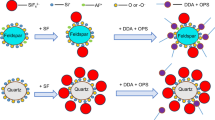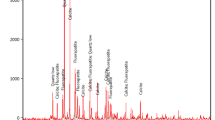Flotation by a vapor-air mixture in a ‘two streams’ scheme was used to de-iron unconditioned sands with 0.34 wt.% Fe2O3: the foam product of the flotation stream I is separated from 1/2 of the sands and mixed with the other 1/2 of the sands by flotation stream II. A distinguishing feature of flotation stream II is that a mixture of air with hot (> 100°C) water vapor is used as the gas phase, which yields VS-030-V grade sand. The consumption of the warming vapor in the vapor-air flotation technology equals 9.7 × 10-4 Gcal/ton of sand.


Similar content being viewed by others
References
V. P. Zhukov, E. V. Barochkin, A. Yu. Nenaezdnikov, et al., “Evolution of the interphase heat-exchange surface in a bubbling bed,” Vest. IGÉU, No. 4, 1 – 5 (2012).
A. N. Mel’sitov and V. A. Petushkov, “Local wave processes caused in a liquid by limiting transitions of an isolated vapor bubble,” Matem. Model., 15(11), 51 – 68 (2003).
A. V. Korolev, “Characteristics of the pressure jump in vapor-water injectors,” Énergetika: Izv. Vyssh. Uchebn. Zaved. i Énerg. Ob’edinenii SNG, No. 6, 31 – 36 (2009).
V. Sh. Shagapov, S. A. Lepikhin, and I. A. Chiglintsev, “Propagation of compression waves in a bubble liquid, accompanied by hydrate formation,” Teplofiz. Aeromekh., 17(2), 247 – 260 (2010).
S. N. Vavilov, A. V. Zhatukhin, and A. N. Kireeva, “Investigation of the contact of cold heat-carrier with a superheated surface,” Teplovye Prots. v Tekh., No. 3, 118 – 121 (2011).
L. B. Boinovich, “Long-range surface forces and their role in the development of nanotechnology,” Usp. Khim., 76(5), 510 – 528 (2007).
S. I. Evdokimov and A. M. Pan’shin, “Surface forces in particle flotation and aggregation processes,” Izv. Vyssh. Uchebn. Zaved., Tsvetn. Met., No. 3, 7 – 11 (2009).
A. M. Pan’shin, S. I. Evdokimov, and S. V. Artemov, “Research on the flotation of a vapor-air mixture,” Izv. Vyssh. Uchebn. Zaved., Tsvetn. Met., No. 1, 3 – 10 (2012).
A. C. Simonsen, P. L. Hansen, and B. Klosgen, “Nanobubbles give evidence of incomplete wetting at a hydrophobic interface,” J. Colloid Interface Sci., 273, 291 – 299 (2004).
M. A. Hampton and A. V. Nguyen, “Nanobubbles and the nanobubble bridging capillary force,” Adv. Colloid Interface Sci., 154(1 – 2), 30 – 55 (2010)
This article is based on work performed in fulfilling a grant contract No. 14.577.21.0142, dated November 28, 2014, with the unique identifier of applied scientific research and experimental work (project) RFMEFI57714X0142.
Author information
Authors and Affiliations
Corresponding author
Additional information
Translated from Steklo i Keramika, No. 4, pp. 29 – 32, April, 2015.
Rights and permissions
About this article
Cite this article
Evdokimov, S.I., Galachieva, S.V., Puzin, V.S. et al. Removal of Iron Minerals from Glass Quartz Sand by Flotation. Glass Ceram 72, 139–141 (2015). https://doi.org/10.1007/s10717-015-9742-2
Published:
Issue Date:
DOI: https://doi.org/10.1007/s10717-015-9742-2




